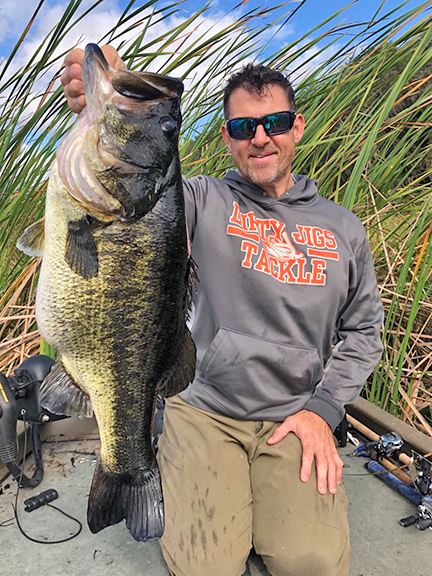
It has been another exciting year as TrophyCatch wraps up Season 8! Note that you still have until October 15 to submit any bass caught between October 1, 2019 and September 30, 2020. As this newsletter goes out, our current season leader is Vance McCullers with an amazing 15 lbs. 2 oz. catch from Polk County waters (left). Other interesting Season 8 statistics to date include:
- 1,088 Lunker Club bass (8 - 9.9 lbs.) submitted
- 299 Trophy Club bass (10 - 12.9 lbs.)
- 22 Hall of Fame bass (13+ lbs.)
- 30,048 total TrophyCatch program registrants
- 85,253 TrophyCatch newsletter subscribers
If you fish for bass and are not already involved, you can show your support for bass conservation and be counted by registering for TrophyCatch here — and you are automatically entered into a free random drawing for a Phoenix Boats 819 Pro bass boat powered by Mercury, guided by Lowrance and anchored by Power-Pole! You will want to stay tuned for upcoming news about the Season 8 Phoenix bass boat drawing and Hall of Fame ceremony! To do so, subscribe to our "TrophyCatch T-Mail" here by providing your email address and checking the "TrophyCatch" box under the "Freshwater Fishing" category. We thank all our participants for their contributions toward making the program a success, and thank our partners like Bass Pro Shops for making the program fun and rewarding!
|
How big do you think this bass is? Ten pounds? Seven? Twelve? A unique study by the FWC along with partner, Bass Pro Shops recently revealed that guessing right is harder than you think — whether you are an experienced bass angler, fishing guide or even a bona fide fisheries biologist. The Eyeball Challenge arose from FWC’s TrophyCatch program, which collects data on bass eight pounds or larger from anglers for use in fisheries management and conservation. The core requirement for submission is a photo or video of the entire bass on a scale with the weight reading clearly visible. And, every trophy bass must be released.
“Given the very specific submission requirements, I’m still a bit mystified whenever I get the ‘That bass isn’t ten pounds!’ comment on one of our posts,” says biologist and TrophyCatch Facebook Manager, John Cimbaro. “If there’s one thing I’ve learned from looking at thousands of bass photos, it’s that the same fish can look very different depending on how the picture is taken and how the fish is held. A hero shot of the angler holding his trophy bass up is usually the best-looking photo for a Facebook post. But the fish-on-scale photo is the one that matters for the research program, and that’s the photo l point a doubting commenter to.”
The Eyeball Challenge asked anglers to estimate the weights of bass in three separate challenges, each with a series of photos. Each bass was weighed by a biologist with field scales to ensure accuracy. The Eyeball Challenge culminated in August with Round 3, which featured twenty-four individual Florida bass. Nearly 900 anglers completed the final round, and the results were quite revealing: on average, anglers were off by plus or minus 2.22 pounds per bass. Even the top 5% of all guessers — the A-pluses at the head of the class — were only able to shave their error down to plus or minus 1.35 pounds of the actual weight.
Does fishing experience endow anglers with weight-guessing skills? Eyeball Challenge participants told us if they identified as novice, intermediate or avid anglers, and they provided the number of years of bass fishing experience they had accrued. Interestingly, statistical testing indicated that there was no performance difference among the three levels of anglers. Technically, increased years of bass fishing experience translated into statistically significant improvements in guessing bass weights, but in practical terms, it takes anglers a lifetime of fishing experience (60 years) to gain only about one-half pound of accuracy over inexperienced anglers. The bottom line is that no matter how good you are at catching fish or how long you’ve been fishing; a variety of factors makes it hard to accurately guess the weight of a fish from a photo.
One key result from the Eyeball Challenge was that how an angler holds his or her bass in a photo makes quite a difference in how we perceive it. One-half of the bass featured in the Round 3 survey were held out toward the camera, at arm’s length. The others were held much closer to the angler’s torso. As anglers might guess, there was a highly significant difference in anglers’ ability to accurately guess the weights of bass in the two groups. Anglers were much more accurate at guessing weights of bass held at arm’s length but had a slight bias towards overestimating those bass. For bass held close to the body, anglers underestimated those bass by over 1.25 pounds on average.
“It’s now scientifically proven — If you want the best photos of your catch, do hold that fish out toward the camera,” says biologist Drew Dutterer, who helped to design the study. “If not, it may be impossible to convince your fishing buddies just how big that bass really was!”
Who's holding the biggest fish? A variety of factors affect how big a bass looks in a picture, illustrated by the same two bass in both of these photos above.
The TrophyCatch program has been popular for not only allowing citizen-scientists to contribute their data, which anglers report is their primary reason for submitting catches, but because industry partners like Bass Pro Shops provide rewards for participation. To register for TrophyCatch and learn more, visit TrophyCatch.com.
This web page provides additional details about the TrophyCatch Eyeball Challenge.
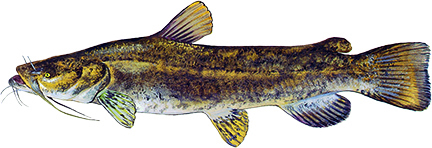
Size: One of the largest fish to be found in Florida's fresh waters, the flathead catfish grows to huge size and the new State Record is 69.9 lbs. (see below). The Big Catch minimum sizes are 25 lbs. or 36 inches for adults, and 18.75 lbs. or 27 inches for youth.
Identification and similar species: A flat head, tiny eyes, square-ish tail and protruding lower jaw distinguish the flathead from other catfish species. They are yellow-brown, usually mottled above, with a creamy colored belly.
Angling qualities: Their solitary lifestyle makes them more difficult to catch than other catfish. They bite best at night while in shallow water looking for food. To catch flatheads, anglers typically fish on the bottom using heavy tackle with live or freshly cut fish..
Where to find them: Flathead are found in the Apalachicola and Escambia rivers, where they recently arrived from Georgia and Alabama. Flatheads prefer long, slow-flowing, moderately-turbid rivers.
Interesting facts: Spawning occurs in late spring. One or both parents excavate the nest that is usually made in a natural cavity or near a large submerged object. Females lay a golden-yellow mass of up to 100,000 eggs. The nest is guarded, and the eggs are agitated by the male to keep them clean and aerated. They feed on other fish, especially catfish and sunfish.
|

A new State Record flathead catfish was just recently certified by FWC. The fish, caught by angler Lavon Nowling (left) from Santa Rosa County, weighed 69.9 pounds, measuring 48.5 inches long, with a girth of 38.25 inches. Nowling caught his flathead catfish on rod and reel using live bait in the Yellow River. “I’ve caught some good ones before this fish, but none of them were more than 54 pounds,” said Nowling. “I’ve been fishing since I was old enough to hold a pole and have been fishing on Yellow River as long as I can remember.” Nowling brought his catch to the FWC’s Blackwater Hatchery near Holt, where biologists weighed it on a certified scale. The last state record flathead catfish was caught in 2019 on the same river. That fish was caught by Marvin Griffin and weighed 69.3 pounds. You can check the Florida Freshwater State Records website for current standings, and review this news release for information about how to submit a potential new Florida freshwater State Record fish.
|
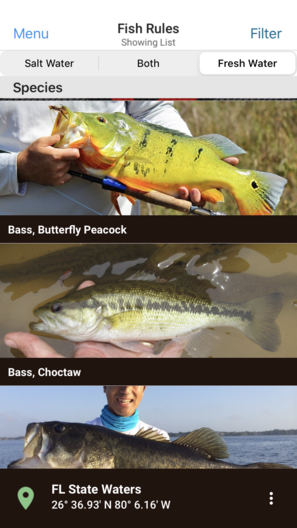 |
The wait is over! Fish Rules App now includes freshwater fishing regulations. The FWC is excited to announce that their successful partnership with the Fish Rules App has now expanded.

Fishing regulations change depending on your location, such as in a Fish Management Area. Enable location services in the Fish Rules App, and the app will automatically show you regulations for your actual position. The app is also partnering with the South Atlantic Fishery Management Council and the Gulf of Mexico Fishery Management Council who manage fisheries off Florida in federal waters.
If you are unsure of the species you reeled in, the app also helps with fish identification. Swipe left or right on pictures of fish to see more pictures and clues on how to identify a fish. You can even sort fish by name or by picture.
If you have beautiful photos of your catch, Fish Rules is always looking for more photos to add to the app. Share your amazing shots by emailing them to photo@fishrulesapp.com. Preferred shots include the fish being held horizontally and taking up as much of the image as possible.
Learn more at FishRulesApp or follow Fish Rules at https://www.instagram.com/FishRulesApp/ or Facebook.com/FishRulesApp.
|
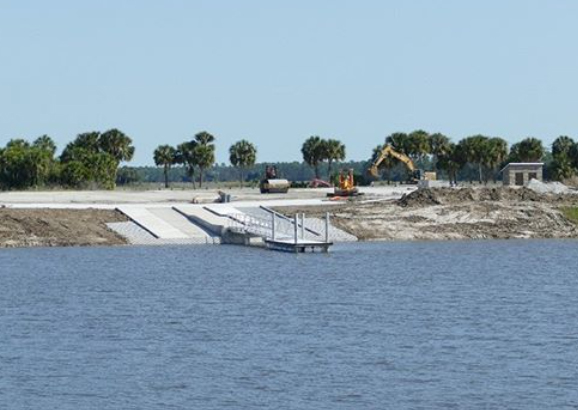
The St. John’s River Water Management District, in partnership with FWC, has announced the Fellsmere Reservoir boat ramp in Indian River County opened to the public on Monday, Aug. 10. The highly anticipated boat ramp, parking area and restrooms will provide anglers access to 10,000 acres of prime largemouth bass and other sport fishing opportunities.
The FWC contributed $1.35 million dollars on enhancing 2,000 acres of habitat over a 2-year period, as well as stocking nearly 2 million sport fish, including 1 million largemouth bass. FWC biologists have been monitoring and evaluating fish populations, habitat and water quality in order to develop management strategies that will allow Fellsmere to sustain a world-class bass fishery for the future of the Fishing Capital of the World.
“The FWC is thrilled to have partnered with the SJWMD on this eagerly awaited project guaranteed to be an outstanding freshwater fishing attraction,” said FWC Commissioner Gary Lester. “Fellsmere Reservoir boat ramp will provide more access to freshwater fishing for Florida’s anglers and will ensure the Sunshine State continues to be the Fishing Capital of the World!”
Fellsmere Reservoir will be managed under state-wide freshwater fishing regulations. The FWC will use data collected from fish population sampling and angler creel surveys to inform future management actions.
|
 |
The FWC's Blackwater Hatchery celebrated 80 years of operation on Friday, Aug. 14. Since 1940, Blackwater has produced tens of millions of fingerling and subadult freshwater fish that have been stocked in Florida’s freshwater lakes and rivers. The hatchery is in Santa Rosa County, approximately five miles west of Holt, within the Blackwater River State Forest.
Original construction of what was then known as the Blackwater River State Fish Hatchery and Game Farm began in the late 1930s as a joint project between the then-Florida Board of Forestry and the U.S Department of Agriculture. The project was completed in 1940 and turned over to the former Game and Fresh Water Fish Commission to manage and develop production techniques. Species produced at the hatchery include largemouth bass, Gulf Coast striped bass, white bass, hybrid bass, shoal bass, black crappie, bluegill, redear sunfish, channel catfish and threadfin shad.
Today, Blackwater Hatchery produces and stocks between 600,000 and 1 million fingerling and subadult freshwater fish annually in public waterbodies throughout Florida to meet conservation goals and the needs of anglers. All hybrid striped bass and Gulf Coast striped bass stocked by the FWC in Florida waters originate from spawning conducted at the hatchery. The FWC is part of a tri-state agreement to conserve and restore the Gulf Coast striped bass population. The only remaining Gulf Coast striped bass populations found in northwest Florida coastal rivers today are a result of fish produced and stocked by the hatchery.
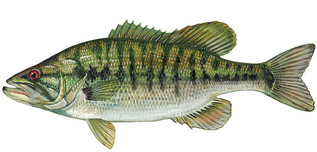
Recently, Blackwater Hatchery has begun investigating techniques for successfully spawning shoal bass (shown to right) in hatchery ponds. Shoal bass are a riverine species of black bass and Florida’s only pure population is found in the Chipola River. Due to limited suitable habitat and their restricted range, shoal bass are listed as a Species of Greatest Conservation Need. The shoal bass population in the Chipola River and its tributaries were negatively impacted by Hurricane Michael. Development of successful hatchery spawning and rearing techniques will be important in ensuring the long-term health and survival of this population.
Blackwater Hatchery will continue to play an integral role in the Division of Freshwater Fisheries Management’s efforts to sustain and conserve Florida’s bountiful freshwater fish populations as we move into the next 80 years and beyond.
For more information about FWC's hatcheries including stocking lists and an interactive stocking map, see the FWC Freshwater Fish Hatcheries web page.
|
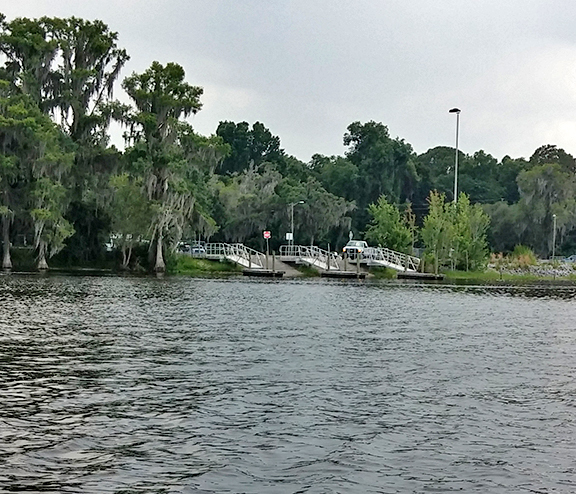
Size: 19,111 acres.
Location: Citrus County near Floral City, Inverness and Hernando.
Description: The Tsala Apopka Chain of Lakes is a series of nutrient-rich lakes connected to the Withlacoochee River that make up the largest freshwater resource in Citrus county. Thick marsh and swamp surround much of the open water in this interesting system. Three main open water pools (named for their nearby cities), separated by water control structures, make up the chain, and several lakes comprise each pool. The northernmost pool is Hernando (contains Point Lonesome, Van Ness, Croft, Hernando, Bellamy, Todd, and Dodd lakes). The next pool heading south is Inverness (contains Davis, Spivey, Henderson, and Little Henderson lakes). The southernmost pool is Floral City (contains Floral City, Hampton, and Tussock lakes).
Bass fishing is popular on this chain which brags 250 TrophyCatch submissions. Most tournaments take place on Henderson and Hernando lakes. According to tournament data, Henderson and Hernando are tied dead-even when it comes to average big bass weight, but slightly more bass have been caught in Henderson. Lately, Hernando is trying to give Henderson a run for its money by having more TrophyCatch submissions coming out of it. Average winning weights for this year are 12.75 pounds for Henderson and 11.1 pounds for Hernando. According to FWC sampling data for this past year, however, the highest catch rates and largest bass were found in Floral City Lake. What this all means is wherever you go, there is a good chance you will have a great time!
|
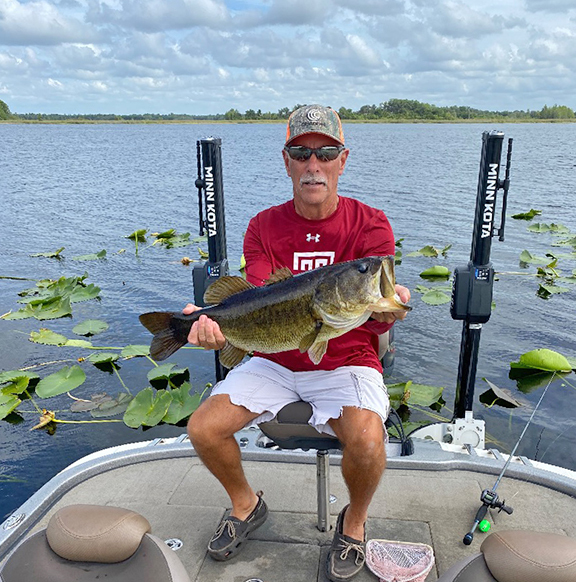
Fishing has slowed a bit in the heat and bass anglers should fish early or late in the day around areas of vegetation or water flow. Live shiners work well here, as do plastic worms. If you wish to brave the heat, try fishing deeper water near structure. As the daylight begins to fade, move into the shallows to produce strikes as bass move in to feed. As fall and winter approach, bass will begin to feed more actively and be easier to catch. Before you know it, bass will be bedding and spawning. Remember to check weather reports. During a cold front, the fish are likely to move into deeper water. On a warm winter’s day, look for fish in the shallows. For bream, this means targeting shallow, sandy bottom areas with vegetation or other structure on the warm days and fishing deeper water near structure on cold days. Traditional baits like crickets, grass shrimp or worms will attract bream.
Crappie fishing is popular on the chain and will be “heating up” as the weather cools. Good crappie fishing can be found through spring. Live minnows and red worms are the best baits for crappie here. Grass shrimp fished on jigs should work as well. If you prefer the artificial route, try beetle spins or white plastic grubs. Fish deeper water along the pads or grass to locate schools. You may have to experiment with different depths initially. Once found, keep fishing at that depth. Look for crappie to move into shallow water to prepare to spawn in late winter/early spring.
Catfish are commonly found throughout the chain near submersed woody structures, bridge pilings, and rip-rap. It is recommended to use a strong leader line as the rough edges of rocks and concrete can fray the line. Catfish bite stinky baits like chicken liver as well as traditional baits such as worms.
Current water levels are high. Water control structures have been closed to retain water at their current levels for as long as possible as we approach the dry season. Check the Tsala Apopka Fishing Forecast for the latest information. Several boat ramps provide access to the pools and include the Hernando public ramp, North Apopka Avenue ramp, Lake Henderson public ramp, Eden Park, and the Duval Island ramp. These can be found on FWC’s Boat Ramp Finder.
|
To contact the Florida Freshwater Angler, email John Cimbaro.
|